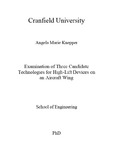JavaScript is disabled for your browser. Some features of this site may not work without it.
| dc.contributor.advisor | Garry, Kevin P. | |
| dc.contributor.author | Knepper, Angela Marie | |
| dc.date.accessioned | 2006-05-12T16:42:02Z | |
| dc.date.available | 2006-05-12T16:42:02Z | |
| dc.date.issued | 2005-12 | |
| dc.identifier.uri | http://hdl.handle.net/1826/1058 | |
| dc.description.abstract | A research programme was initiated to examine three candidate high-lift technologies, which would, if implemented, simplify the mechanical complexity of the multiple component trailing-edge devices traditionally employed on civil transport aircraft. Experimental studies were undertaken with the aim of examining each technology in terms of its potential to favourably influence boundary layer development and improve the aerodynamic characteristics of a high-lift configuration. Preliminary studies of triangular serrated geometries, at the trailing edge of a modified flat plate, highlighted that the ability of the serrations to favourably influence the flow field development over an aft positioned single slotted flap was critically dependent upon the flap lap/gap and deflection angle. Under the test conditions, the serrations were most effective at low flap deflection angles, particularly serrations with a length corresponding to 13% flap chord. Extending these studies to a representative high-lift configuration significantly limited the range of flap laps/gaps and deflection angles over which the serrations were favourable. Furthermore, oil flow visualisation provided evidence of wake structures emanating from serration vertices, corroborating earlier hypotheses and suggesting the flow mechanism by which serrations favourably influenced boundary layer development over the upper surface of the downstream flap. Experiments indicated that when optimised, blowing tangentially from a slot at the trailing edge of the main element over the upper surface of a flap within a three-element high-lift configuration, provided a highly effective means of preventing boundary layer separation and increasing lift. This was corroborated by oil flow visualisation and computational simulations. Maintaining the same momentum coefficient and blowing through discrete orifices at the trailing edge of the main element, proved highly favourable, heightening the increment in lift in comparison to the corresponding tangential slot blowing configuration. Hence, the mass flow rate could be reduced in comparison to the tangential slot blowing configuration, without compromising the aerodynamic performance. | en |
| dc.format.extent | 7543289 bytes | |
| dc.format.mimetype | application/pdf | |
| dc.language.iso | en | en |
| dc.publisher | Cranfield University | |
| dc.rights | ©Cranfield University, 2005. All rights reserved. No part of this publication may be reproduced without the written permission of the copyright holder. | en |
| dc.title | Examination of three candidate technologies for high-lift devices on an aircraft wing | en |
| dc.type | Thesis or dissertation | en |
| dc.type.qualificationlevel | Doctoral | en |
| dc.type.qualificationname | PhD | en |
| dc.publisher.department | School of Engineering | en |
